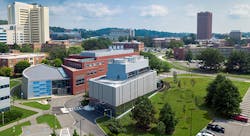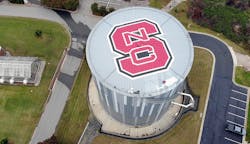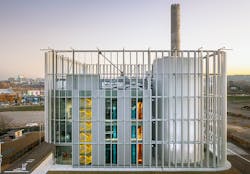The latest grim warning about climate change came in March when a report from the United Nations Intergovernmental Panel on Climate Change declared that the world is likely to pass a dangerous temperature threshold within the next 10 years unless nations immediately transition away from fossil fuels.
Previous pronouncements about the harmful effect of greenhouse gas emissions have not persuaded enough people to the take the urgent actions needed to reverse global warming, but the message has been taken seriously at many U.S. colleges and universities. Through initiatives like the American College and University Presidents’ Climate Commitment, hundreds of higher education institutions have pledged to decarbonize—reduce the carbon footprint generated by buildings and operations on their campuses—and have taken concrete steps to make the pledges a reality.
Several schools have attained carbon neutral status or have made significant progress.
“It used to be, ‘How are we going to do this? This is so hard. No one is listening to me. No one’s funding this. What are we going to do?’” says Martha Larson, director of sustainability for RMF Engineering, which works with colleges and universities on campus decarbonization. “Now the conversations all say, ‘Here’s a project that’s done. Here’s a campus that reduced carbon emissions by 70% or 80%...People have demonstrated practical solutions and really remarkable results.”
Beyond a buzzword
It has six syllables and might be considered what people used to call a ten-dollar word. But decarbonization has become a familiar term among those pursuing sustainability efforts on education campuses. The meaning is straightforward—getting rid of carbon emissions.
In her work helping campuses develop their sustainability plans and reduce their carbon footprint, Larson says her approach consists of three pillars:
- Understanding the energy base
“A lot of the work we do is to simply take existing data, both at the campus level ad at the building level, and put that into digestible formats with really clear data visualization so that we assess and evaluate and make decisions that are informed by how the campus is performing," Larson says.
- Reducing demand
“Campuses are good at this,” Larson says. “They’re getting pretty good at justifying and completing projects based on an energy savings payback."
- Future-forward solutions
“This is where we get into more of the innovative solutions that we call campus decarbonization,” Larson says.
Many college campuses are good candidates for successful decarbonization because they have district energy systems where a central plant generates energy for many facilities—anywhere from 50% to 90% of the buildings on a campus.
A long game
Schools should understand that carrying out a decarbonization plan will take time.
“This is always going to be a phased approach,” Larson says. “All that money, all that construction, all those building transformations—they can’t happen all at one time. The idea of it being overwhelming, too expensive, never able to do it—when you think of it on a 20- to 30-year timeline, it becomes a lot better fit. the most important thing is being able to see over the horizon, and once you’ve got that long-term road map, all of your short-term decisions can start to point in that direction.”
Some of the short-term steps to reduce greenhouse gas emissions include lighting and building controls.
“Lighting is the biggest bang for the buck in terms of paybacks,” Larson says. “That’s the first thing people look to—some sort of lighting controls whether it’s occupancy sensors or timers.”
Universities also can take advantage of heat recovery opportunities. “Are there places where we have exhaust air leaving the building a lot,” Larson says, “or where we have some sort of heat-intense operation like a data center where we can funnel waste heat even within the building?”
Setting priorities
To be successful in achieving carbon neutrality, advocates for sustainability have to be cognizant of an institution’s existing priorities and try to mesh their climate goals with them.
Persuading others on campus to embrace sustainability initiatives will help education institutions show progress toward achieving their climate goals.
“The people inside the organization—the people doing the work day to day—need to care about it and advocate for it and understand it and be able to talk about it,” Larson says. “So do the director-level people; so do the administrators and the key board members. Giving them a language and educating them so they can become project champions—that’s also part of the job.”
Mike Kennedy ([email protected]) is senior editor at American School & University.
Sidebar
Carbon Neutrality: A Work in Progress
Since late 2006, when a group of college and university presidents initiated the American College & University Presidents’ Climate Commitment, many institutions have taken steps to reduce their carbon footprint. But only a handful have been able to reach carbon neutrality on their campuses.
What is keeping schools from making greater progress in their clean energy goals?
Nelnet Renewable Energy, a company that facilitates clean energy solutions, has tried to answer that question in a 2022 white paper, “Why Your College Hasn’t Achieved Carbon Neutrality (Yet).”
A survey of more than 250 sustainability professionals, students and faculty members identified four general issues that have proven to be impediments:
- A lack of financial resources, or other priorities for those resources. About two-thirds of survey respondents say their institution either lacks the financial resources to achieve carbon neutrality or has other priorities for those resources.
- A lack of stakeholder buy-in from administration. “In many cases, stakeholders at the highest level claim carbon neutrality as a top priority...but fail to allocate effective resources to make it a reality,” the paper says.
- A lack of staffing resources and on-campus expertise. “For institutions without appropriately dedicated resources, the development and implementation of a campus decarbonization plan, and the measurement of outcomes, often feels like a mountain that can’t be climbed,” the paper says.
- Difficulties associated with the geographical location of the institution. Not all jurisdictions offer incentives for clean energy initiatives such as solar or wind. Campuses also are at the mercy of their local weather patterns and their heating and cooling needs may force them to rely on less environmentally friendly energy production. Urban campuses may not have the space needed to make infrastructure changes to carry out clean energy initiatives.
About the Author
Mike Kennedy
Senior Editor
Mike Kennedy, senior editor, has written for AS&U on a wide range of educational issues since 1999.



